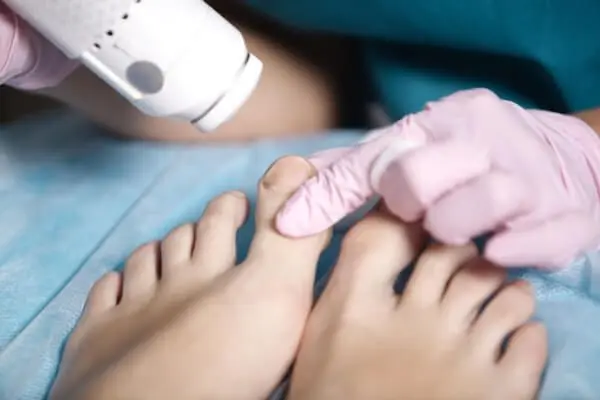EUP
Toenail fungus, medically known as onychomycosis, is a common condition that affects millions of people worldwide. It can cause thickened, discolored nails, leading to discomfort, pain, and self-consciousness.
If you’re dealing with toenail fungus, you’re likely searching for the best toe fungus killer to eliminate this persistent problem. In this article, we will explore various treatment options and guide you toward finding the most effective solution for your toenail fungus issues.
Understanding Toenail Fungus
To tackle fungal infections of the nail effectively, it’s important to understand the condition itself. Toenail fungus is typically caused by dermatophyte fungi that thrive in warm, moist environments like shoes and socks. Factors such as poor hygiene, walking barefoot in public places, compromised immunity, and certain medical conditions can increase the risk of developing fungal nail infections.
Recognizing the signs, such as yellowing, thickening, brittleness, and distortion of the nails, will help you seek appropriate treatment promptly. Here are some symptoms of toenail fungus:
Nail Discoloration – One of the primary symptoms of toenail fungus is a noticeable change in the color of the affected nail. The nail may turn yellow, brown, green, or even black. In some cases, the discoloration may be localized to certain areas of the nail, while in others, it can spread throughout the entire nail. If you notice abnormal nail discoloration that doesn’t improve or worsen over time, it may be an indication of toenail fungus.
Thickened and Brittle Nails – Toenail fungus often causes the affected nail to become thicker than usual. The nail may also become brittle and prone to crumbling or breaking easily. As the infection progresses, the nail texture may become rough or ragged. If you experience changes in nail thickness, brittleness, or a generally unhealthy appearance, toenail fungus could be the culprit.
Distorted Nail Shape – As toenail fungus advances, it can lead to changes in the shape and structure of the affected nail. The nail may become warped, twisted, or unusually curved. The edges of the nail may lift or separate from the nail bed, a condition known as onycholysis. If you observe any changes in the shape or structure of your toenails, it’s important to consider the possibility of toenail fungus.
Foul Odor – Toenail fungus can also cause an unpleasant odor emanating from the infected nail. The combination of fungal overgrowth, moisture, and bacterial activity can create a distinct smell. If you notice an unpleasant odor coming from your toenails, especially if accompanied by other symptoms, it could be an indication of toenail fungus.
Pain or Discomfort – In some cases, toenail fungus can lead to pain or discomfort. The affected nail may cause discomfort while wearing shoes or applying pressure. In severe cases, the infection can cause inflammation and tenderness in the surrounding skin. If you experience pain, tenderness, or discomfort related to your toenails, it’s important to consider the possibility of toenail fungus.
Contact us now to discuss your foot and ankle health needs.
Exploring Treatment Options
- Topical Treatments:
Topical antifungal medications are often the first line of defense for mild to moderate cases of toenail fungus. These treatments come in the form of creams, lotions, or nail lacquers. They work by directly targeting the fungus on the nail surface and penetrating through the nail plate to reach the infection. Look for over-the-counter options containing active ingredients like clotrimazole, terbinafine, or ciclopirox. Prescription-strength topical medications may also be prescribed by your podiatrist for more severe cases.
- Oral Medications:
For more advanced or persistent toenail fungus infections, oral antifungal medications may be recommended. These medications are taken for a specified duration, typically several weeks or months, and work systemically to attack the fungus throughout your body. Commonly prescribed oral antifungal drugs include terbinafine, itraconazole, and fluconazole. It’s important to note that these medications may have potential side effects, so consulting with a healthcare professional is essential.
- Laser Treatment:
Laser therapy is a relatively newer option for treatment of nail fungus that has gained popularity due to its promising results. This procedure involves using a laser device to emit focused energy onto the infected nail, effectively killing the fungus while leaving surrounding tissue unharmed. Laser treatment is non-invasive, painless, and generally requires multiple sessions for optimal results. It is particularly beneficial for individuals who prefer non-chemical or non-systemic approaches.
Factors to Consider for Effective Toe Fungus Treatment
- Severity of the Infection:
The severity of your toenail fungus infection plays a crucial role in determining the most effective treatment. Mild cases may respond well to topical treatments, while more severe or recurring infections may require oral medications or laser therapy. Consulting with a podiatrist will help determine the best course of action based on the extent of the infection.
- Treatment Duration:
Different treatment options have varying durations. Topical treatments usually require daily application over an extended period, while oral medications may involve weeks or months of consistent use. Laser therapy often involves multiple sessions, spaced several weeks apart. Consider your lifestyle, commitment to treatment, and expected results when choosing the best treatment of toenail fungus for you.
- Safety and Side Effects:
Each treatment option carries its own potential side effects and safety considerations. Topical treatments generally have minimal side effects but may take longer to show visible improvements. Oral medications can have interactions with other medications and may cause liver or gastrointestinal issues. Laser therapy is considered safe but may cause temporary discomfort during the procedure. Discuss these aspects with your podiatrist to make an informed decision.
Need more help with foot fungus?
When it comes to finding the best toenail fungus treatment, it’s essential to consider the severity of your infection, the treatment duration, and the safety of different options. Whether you opt for topical treatments, oral medications, or laser therapy, consulting with a professional podiatrist is crucial for accurate diagnosis and personalized treatment plans.
If you’re in search of a trusted podiatry practice in New Jersey, look no further than Essex Union Podiatry. Our team of experienced podiatrists specializes in treating toenail fungus and a wide range of foot and ankle conditions. To take the first step towards healthier, fungus-free nails, get in touch with Essex Union Podiatry today. Our experts are ready to help you regain your confidence and put your best foot forward.
Our advanced podiatry treatments can help relieve your foot and ankle issues.

